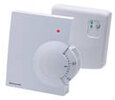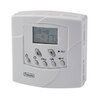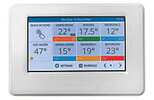I've just started reading up on weather compensation systems that can be retrofitted with the aim of reducing the flow temperature to maximise the efficiency of a condensing gas boiler, as and when appropriate.
In 2009 with the extension I had a new boiler fitted, a Baxi Duo-tec combi boiler. It is very clear online that weather compensation can be retrofitted to a Duo-tech boiler. I also suspect Baxi use a common control PCB (Siemens made) for various models boilers.
The problem is a little more complicated here.
There is a hot water cylinder for the bathrooms /and/ there is a combi setup for hot water on demand for the kitchen and utility room which I thought practical because of the distance from one end of the bungalow to another.
The problem with weather compensation or system boilers specifically is that lowering the flow temperature risks legionella etc developing in the hot water cylinder.
The question is, when used as a combi-boiler /and/ with a hot water cylinder, does the Duo-tec have the capability to have an input from the timer/controller (or via the valve wiring) to set the flow temperatute back to 80/60 when the hot water cylinder is demanding heat (regardless of whether the heating zones 1 & 2 are) thus sastisfying all the safety requirements?
I wasn't easily able to discover if this is the case. I gave up waiting on the phone to Baxi after 40 mins. Anyone have experience of this?
Michael
P.S. Until this morning I wasn't aware that most of the time, condensing boilers aren' actually condensing at all and they don't run near max efficiency if the flow temp is set constantly to cater for a HW cylinder. Blimey.
In 2009 with the extension I had a new boiler fitted, a Baxi Duo-tec combi boiler. It is very clear online that weather compensation can be retrofitted to a Duo-tech boiler. I also suspect Baxi use a common control PCB (Siemens made) for various models boilers.
The problem is a little more complicated here.
There is a hot water cylinder for the bathrooms /and/ there is a combi setup for hot water on demand for the kitchen and utility room which I thought practical because of the distance from one end of the bungalow to another.
The problem with weather compensation or system boilers specifically is that lowering the flow temperature risks legionella etc developing in the hot water cylinder.
The question is, when used as a combi-boiler /and/ with a hot water cylinder, does the Duo-tec have the capability to have an input from the timer/controller (or via the valve wiring) to set the flow temperatute back to 80/60 when the hot water cylinder is demanding heat (regardless of whether the heating zones 1 & 2 are) thus sastisfying all the safety requirements?
I wasn't easily able to discover if this is the case. I gave up waiting on the phone to Baxi after 40 mins. Anyone have experience of this?
Michael
P.S. Until this morning I wasn't aware that most of the time, condensing boilers aren' actually condensing at all and they don't run near max efficiency if the flow temp is set constantly to cater for a HW cylinder. Blimey.






